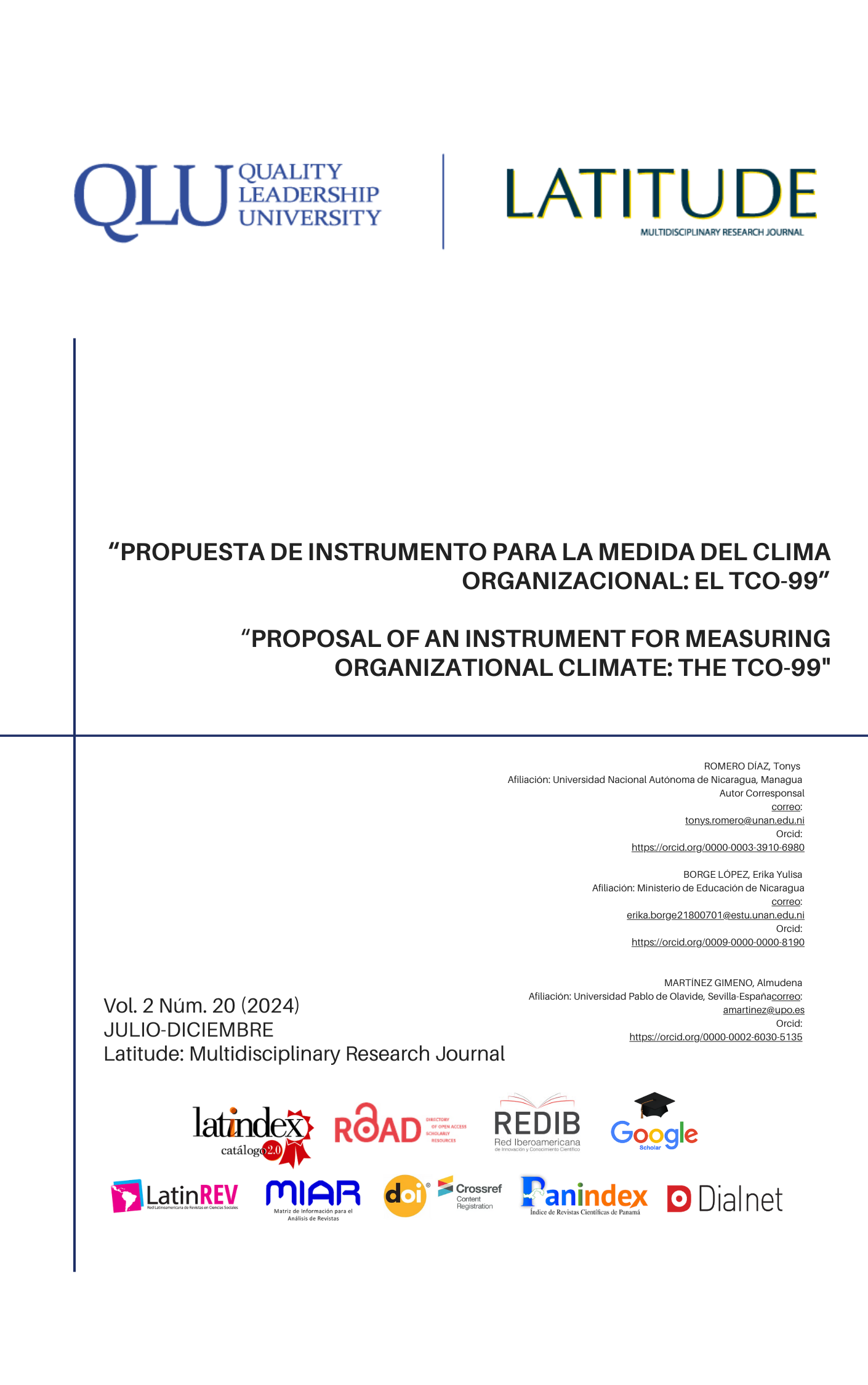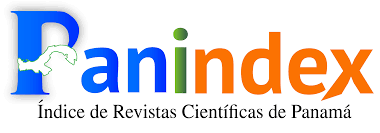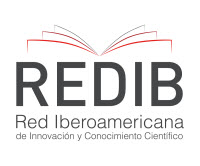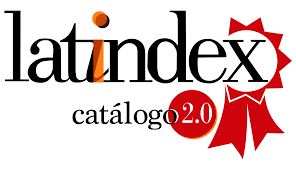

Esta obra está bajo una licencia internacional Creative Commons Atribución-NoComercial-CompartirIgual 4.0.
Esta obra está bajo licencia internacional https://creativecommons.org/licenses/by-nc-sa/4.0/deed.es
La revista (y sus contenidos) emplean las licencias Creative Commons, específicamente la del tipo CC BY NC SA 4.0, la cual establece que “el beneficiario de la licencia tiene el derecho de copiar, distribuir, exhibir y representar la obra y hacer obras derivadas siempre y cuando reconozca y cite la obra de la forma especificada por el autor o el licenciante”. La licencia del tipo CC BY NC SA 4.0 contempla tres categorías,
- Atribución.
- No Comercialización de la obra.
- Compartir igual
Los lectores son libres de:
- Compartir — copiar y redistribuir el material en cualquier medio o formato
- Adaptar — remezclar, transformar y construir a partir del materialLa licenciante no puede revocar estas libertades en tanto usted siga los términos de la licencia
- Siempre y cuando se respeten y contemplen la atribución de autoría y la no comercialización del material.
Resumen
El clima organizacional se define como el significado compartido que los miembros de una organización atribuyen a eventos, políticas y prácticas, y refleja las características de la organización y las percepciones de sus miembros. Este trabajo tiene como propósito el diseño de un instrumento para medir el clima organizacional (TCO-99). El TCO-99 contiene 99 preguntas y nueve dimensiones, fue evaluado utilizando una muestra de 87 personas de una institución pública colombiana y se probó la validez convergente con una escala de referencia. Desde el punto de vista psicométrico, el test es confiable con valores del alfa de Cronbach adecuados. Igualmente, las correlaciones significativas y positivas entre las dimensiones del TCO-99 y la escala de referencia, demuestras la validez convergente. La aplicación del test a empresas en Nicaragua y México, reveló que el bienestar, la eficiencia empresarial y las recompensas eran las dimensiones peor valoradas en las tres empresas, mientras que el liderazgo recibía la valoración más positiva. Se sugirió implementar planes de acción para mejorar el bienestar de los empleados, lo que podría mejorar la productividad y el rendimiento general. Se concluye que el TCO-99 es una herramienta confiable y válida para medir el clima organizacional, y su aplicación puede ayudar a las organizaciones a identificar áreas de mejora e implementar estrategias para un clima laboral más positivo.
Palabras clave:
Citas
Abugre, J. B. (2011). Appraising the impact of organizational communication on worker satisfaction in organizational workplace. Problems of Management in the 21st Century, 1(1), 7–15.
Acosta, B., & Venegas, C. (2010). Clima organizacional en una empresa cervecera: Un estudio exploratorio. Revista de Investigación en Psicología, 13(1), Article 1. https://doi.org/10.15381/rinvp.v13i1.3744
Adeseye, B. O., & Ariremako, I. A. (2019). A congenial communication climate: The catalyst and panacea for effective organizational communication. EJOTMAS: Ekpoma Journal of Theatre and Media Arts, 7(1–2), Article 1–2. https://doi.org/10.4314/ejotmas.v7i1-2.26
Amiri, F., Baghbani, M., Hannani, S., & Azadi, N. A. (2023). Impact of organizational climate on the self-efficacy of operating room personnel. Annals of Medicine and Surgery, 85(6), 2414–2419. https://doi.org/10.1097/MS9.0000000000000368
Antsiferova, A. A., Kontsevaya, A. V., Khudyakov, M. B., Ipatov, P. V., & Drapkina, O. M. (2022). Experience in implementing workplace wellbeing programs in Russia: Results of a survey of employers on the ATRIA platform. Cardiovascular Therapy and Prevention, 21(6), Article 6. https://doi.org/10.15829/1728-8800-2022-3266
Aryanti, R., Diah Sari, E., & Widiana, H. (2020). A Literature Review of Workplace Well-Being. Proceedings of the International Conference on Community Development (ICCD 2020). https://doi.org/10.2991/assehr.k.201017.134
Bahrami, M. A., Barati, O., Ghoroghchian, M., Montazer-alfaraj, R., & Ranjbar Ezzatabadi, M. (2016). Role of Organizational Climate in Organizational Commitment: The Case of Teaching Hospitals. Osong Public Health and Research Perspectives, 7(2), 96–100. https://doi.org/10.1016/j.phrp.2015.11.009
Becaro, J. M. G. (2022). The Effect of Organizational Climate to Employee Engagement in a Private Educational Institution. International Journal of Engineering and Management Research, 12(6), Article 6. https://doi.org/10.31033/ijemr.12.6.4
Belay, N. A. (2023). Effect of organisational climate on employees’ organisational affective commitment the case of Ethiotelecom Western Region. International Journal of Economic Behavior and Organization, 11(1), Article 1. https://doi.org/10.11648/j.ijebo.20231101.12
Berberoglu, A. (2018). Impact of organizational climate on organizational commitment and perceived organizational performance: Empirical evidence from public hospitals. BMC Health Services Research, 18, 399. https://doi.org/10.1186/s12913-018-3149-z
Brandolini, A., González, M., & Hopkins, N. (2008). Comunicación interna: Recomendaciones y errores frecuentes (1era ed.). La Crujía.
Candra, A., Sudiro, A., & Susilowati, C. (2023). The relationship between work professionalism and job satisfaction toward employee performance in mediating of
organizational climate. International Journal of Research in Business and Social Science (2147- 4478), 12, 177–186. https://doi.org/10.20525/ijrbs.v12i2.2380
Cardona, D. R., & Zambrano, R. (2014). Revisión de instrumentos de evaluación de clima organizacional. Estudios Gerenciales, 30(131), 184–189. https://doi.org/10.1016/j.estger.2014.04.007
Castro Alfaro, A. (2018). Bienestar como fuente de actuación organizacional. Enfoque Disciplinario, 3(1), Article 1.
Celik, A., Akgemci, T., & Akyazi, T. E. (2016). The relationship between shared vision and organizational climate in learning organizations: A study in the banking sector. International Journal of Academic Research in Business and Social Sciences, 6(2), 197–210.
Chiang, M. M., Salazar, C. M., & Núñez, A. (2007). Clima organizacional y satisfacción laboral en un establecimiento de salud estatal: Hospital tipo 1. Theoria, 16(2), 61–76.
Curilla, S., Morales, J., Poma, W., & Vicente-Ramos, W. (2023). Influence of internal communication on the organizational climate of a local educational management unit in Peru. Business: Theory and Practice, 24(1), Article 1. https://doi.org/10.3846/btp.2023.16358
Deciu, V. (2022). The interplay between personality and organizational climate. Philosophy Study, 12(4). https://doi.org/10.17265/2159-5313/2022.04.004
Del Toro, J. del, Salazar, M. C., & Gómez, J. (2011). Clima organizacional, satisfacción laboral y su relación con el desempeño laboral en trabajadores de una PYME de servicios de ingeniería. CLIO América, 5(10), 204–227.
Díaz, M. G., Peña, M. C., & Castellanos, B. A. (2014). El Liderzago Y Las Relaciones Interpersonales Dentro Del Clima Organizacional (Leadership and Interpersonal Relationships within the Organizational Climate). Leadership & Organizational Behavior eJournal. https://www.semanticscholar.org/paper/El-Liderzago-Y-Las-Relaciones-Interpersonales-Del-D%C3%ADaz-C%C3%A1rdenas/a470e2fdd465a3f9eb2713c3d79e42788717c99c
Dobrowolska, M., Ślazyk-Sobol, M., Flakus, M., & Deja, A. (2020). Climate and ties in workplace versus sense of danger and stress, based on empirical research in the aviation industry. Sustainability, 12(13). https://doi.org/10.3390/su12135302
Ehrhart, M. G., Ehrhart, K. H., & Schneider, B. (2015). Organizational Climate. In Wiley Encyclopedia of Management (pp. 1–3). John Wiley & Sons, Ltd. https://doi.org/10.1002/9781118785317.weom110073
Elda, E., Lubis, M. S. I., & Nurhayati, N. (2022). Climate development and corporate organizational communication satisfaction toward employee performance imporvement. Dharmawangsa: International Journal of the Social Sciences, Education and Humanitis, 3(2), Article 2. https://doi.org/10.46576/ijsseh.v3i2.2970
Ertosun, O. G., & Adiguzel, Z. (2018). Leadership, personal values and organizational culture. In H. Dincer, Ü. Hacioglu, & S. Yüksel (Eds.), Strategic Design and Innovative Thinking in Business Operations: The Role of Business Culture and Risk Management (pp. 51–74). Springer International Publishing. https://doi.org/10.1007/978-3-319-77622-4_3
Field, R. H. G., & Abelson, M. A. (1982). Climate: A Reconceptualization and Proposed Model. Human Relations, 35(3), 181–201. https://doi.org/10.1177/001872678203500302
Freire, R. P. de A. S., Martínez, J. M. de L. T., Hernández, A. M. L., & Paiva, S. B. (2011). El Clima organizacional en el diseño del balanced scorecard: Evaluación psicométrica de un instrumento de medida. Contabilidade Vista & Revista, 22(1), 107–141.
Gaitán Díaz, J. A., Álvarez González, J. E., & Díaz Serrato, Y. Y. (2020). Análisis de la medición del clima organizacional por medio de la aplicación de instrumentos cuantitativos y cualitativos en las áreas administrativas y operativas de las empresas públicas de AIPE (EPA) en el año 2019 [Universidad Cooperativa de Colombia]. https://hdl.handle.net/20.500.12494/17692
Gaitán Díaz, E. V., Ozerov, S. L., & Satina, A. V. (2022). Implementation of the WELL-BEING program to maintain the emotional and psychological state of the company’s employees. Normirovanie i Oplata Truda v Promyshlennosti (Rationing and Remuneration of Labor in Industry), 105–108. https://doi.org/10.33920/pro-3-2202-03
Gómez, C. A. (2004). Diseño, construcción y validación de un instrumento que evalúa clima organizacional en empresas colombianas, desde la teoría de respuesta al ITEM. Acta Colombiana de Psicología, 11, 97–113.
Gould-Williams, J. (2007). HR practices, organizational climate and employee outcomes: Evaluating social exchange relationships in local government. The International Journal of Human Resource Management, 18(9), 1627–1647. https://doi.org/10.1080/09585190701570700
Her, Q. L., & Wong, J. (2020). Significant correlation versus strength of correlation. American Journal of Health-System Pharmacy, 77(2), 73–75. https://doi.org/10.1093/ajhp/zxz280
Hutagalung, D. I. (2020). The influence of organizational climate interpersonal communication organizational commitment to performance of local government in Indonesia. The Journal of Social Sciences Research, 6(5), 494–502.
James, L. R., & Jones, A. P. (1974). Organizational climate: A review of theory and research. Psychological Bulletin, 81(12), 1096–1112. https://doi.org/10.1037/h0037511
Johannsen, R. D., Johnson, T. W., & Stinson, J. E. (1976). Organizational Climate and Productivity. Journal of Management, 2(2), 65–70. https://doi.org/10.1177/014920637600200209
Khetarpal, V. (2010). Role of interpersonal communication in creating conducive organisational climate. ASBM Journal of Management. https://www.semanticscholar.org/paper/Role-of-Interpersonal-Communication-in-Creating-
Khetarpal/f6f6f556ea954d9ac87a2e0d2bc4fcad2bc4e75a
Köse, A. (2016). The Relationship between Work Engagement Behavior and Perceived Organizational Support and Organizational Climate. Journal of Education and Practice, 7(27), 42–52.
Lan, Y.-L., Huang, W.-T., Kao, C.-L., & Wang, H.-J. (2020). The relationship between organizational climate, job stress, workplace burnout, and retention of pharmacists. Journal of Occupational Health, 62(1), e12079. https://doi.org/10.1002/1348-9585.12079
Lannes, H. (2021). Effect of Organizational Communication on Organizational Climate and Organizational Effectiveness. The Undergraduate Journal of Psychology. https://journals.charlotte.edu/ujop/article/view/926
Lecic, M. S., Milic, B., Visnjic, R., & Culibrk, J. (2023). Leadership, Innovative Behavior and the Case of Innovative Climate—When the Mediator Becomes the Mediated. Behavioral Sciences, 13(1), Article 1. https://doi.org/10.3390/bs13010040
Mathew, J., & Selvi, U. (2007). Importance of Organisational Climate in Contemporary Management. Ushus - Journal of Business Management, 6, 61–74. https://doi.org/10.12725/ujbm.11.6
Muslicha, A. N. F., Nurbianta, N., & Herudiati, S. E. (2022). Relationship Between Organizational Climate And Self-Concept With Effectiveness Of Interpersonal Communication. International Journal of Educational Management and Innovation, 3(1), Article 1. https://doi.org/10.12928/ijemi.v3i1.5242
Nielsen, K., Nielsen, M. B., Ogbonnaya, C., Känsälä, M., Saari, E., & Isaksson, K. (2017). Workplace resources to improve both employee well-being and performance: A systematic review and meta-analysis. Work & Stress, 31(2), 101–120. https://doi.org/10.1080/02678373.2017.1304463
Novak, V., Ilienko, O., & Lytvynenko, L. (2017). Personal development in the organization. http://hdl.handle.net/11652/3766
Nurjanah, N., Elvina, E., & Halim, A. (2023). The influence of organizational climate, organizational culture, leadership, and position promotion on employee performance at the office of cooperatives and SMEs in Labuhanbatu Regency. Quantitative Economics and Management Studies, 4(2), 246–260. https://doi.org/10.35877/454RI.qems1519
Okoya, O. (2013). Organisational Climate and Performance: A Case Study of Nigerian High Growth SMEs [PhD, University of East London]. https://doi.org/10.15123/PUB.3932
Payne, R. L., Pheysey, D. C., & Pugh, D. S. (1971). Organization structure, organizational climate, and group structure: An exploratory study of their relationships in two British manufacturing companies. Occupational Psychology, 45(1), 45–55.
Pere, F., Lorenzo-Seva, U., Hernández-Dorado, A., & Muñiz, J. (2022). Decálogo para el Análisis Factorial de los Ítems de un Test. Psicothema, 34(1), 7–17.
Prasetyo, I., Aliyyah, N., Rusdiyanto, Utari, W., Suprapti, S., Ch, Kartika, R., Winarko, R., Chamariyah, Panglipursari, D. L., Muninghar, Halimah, N., Aminatuzzuhro, Indrawati, M., Junus, O., Herli, M., Hafidhah, Kustiningsih, N., Gazali, … Kalbuana, N. (2021). Effects of Organizational Communication Climate and Employee Retention Toward Employee Performance. Journal of Legal, Ethical and Regulatory Issues, 24(1S), 1–11.
Reynolds, G. S., & Bennett, J. B. (2023). The role of wellness climate in small business health promotion and employee wellbeing. Occupational Health Science, 1–36. https://doi.org/10.1007/s41542-023-00148-w
Robakidze, M., & Sologashvili, M. (2022). The relationship between service climate, employee experience and organizational loyalty. Georgian Scientists, 4(1), 73–89. https://doi.org/10.52340/gs.2022.04.01.08
Sahlan, S., Dwi N., O., & Amos, A. (2022). The effect of rewards and organizational climate on the performance of pt tasma puja kampar employees. PENANOMICS: International Journal of Economics, 1(2), Article 2. https://doi.org/10.56107/penanomics.v1i2.30
Sanamthong, E., & Prabyai, S. (2023). A causal model of relationship between organizational climate influencing happiness at work and organization engagement. Emerging Science Journal, 7, 558–568. https://doi.org/10.28991/ESJ-2023-07-02-018
Suryana, D. (2023). The Effect of Organizational Climate and Compensation on Job Satisfaction and Employee Performance. Indonesian Journal of Multidisciplinary Science, 2(7), Article 7. https://doi.org/10.55324/ijoms.v2i7.474
Teetzen, F., Klug, K., Steinmetz, H., & Gregersen, S. (2023). Organizational health climate as a precondition for health-oriented leadership: Expanding the link between leadership and employee well-being. Frontiers in Psychology, 14. https://doi.org/10.3389/fpsyg.2023.1181599
Weinberg, A. (2023). Political Considerations in Implementing Initiatives to Improve the Mental Well-Being of Employees in the Workplace. Medical Research Archives, 11(5). https://doi.org/10.18103/mra.v11i5.3725
Wudarzewski, G. (2017). Koncepcja marketingu personalnego jako wyznacznika klimatu organizacyjnego. Annales Universitatis Mariae Curie-Skłodowska, sectio H – Oeconomia, 51(2). https://doi.org/10.17951/h.2017.51.2.273
Wziątek-Staśko, A., & Krawczyk-Antoniuk, O. (2021). Pro-Efficiency Model of the Organizational Climate. Journal of Organizational Management Studies, 1–20. https://doi.org/10.5171/2021.216555
Zolak Poljasevic, B., Došenović, D., & Todorovic, M. (2021). Interpersonal relationship as a factor of job satisafaction. Sted Journal, 3. https://doi.org/10.7251/STED2101021Z

















